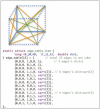Automatic reconstruction of 3D neuron structures using a graph-augmented deformable model
- PMID: 20529931
- PMCID: PMC2881396
- DOI: 10.1093/bioinformatics/btq212
Automatic reconstruction of 3D neuron structures using a graph-augmented deformable model
Abstract
Motivation: Digital reconstruction of 3D neuron structures is an important step toward reverse engineering the wiring and functions of a brain. However, despite a number of existing studies, this task is still challenging, especially when a 3D microscopic image has low single-to-noise ratio and discontinued segments of neurite patterns.
Results: We developed a graph-augmented deformable model (GD) to reconstruct (trace) the 3D structure of a neuron when it has a broken structure and/or fuzzy boundary. We formulated a variational problem using the geodesic shortest path, which is defined as a combination of Euclidean distance, exponent of inverse intensity of pixels along the path and closeness to local centers of image intensity distribution. We solved it in two steps. We first used a shortest path graph algorithm to guarantee that we find the global optimal solution of this step. Then we optimized a discrete deformable curve model to achieve visually more satisfactory reconstructions. Within our framework, it is also easy to define an optional prior curve that reflects the domain knowledge of a user. We investigated the performance of our method using a number of challenging 3D neuronal image datasets of different model organisms including fruit fly, Caenorhabditis elegans, and mouse. In our experiments, the GD method outperformed several comparison methods in reconstruction accuracy, consistency, robustness and speed. We further used GD in two real applications, namely cataloging neurite morphology of fruit fly to build a 3D 'standard' digital neurite atlas, and estimating the synaptic bouton density along the axons for a mouse brain.
Availability: The software is provided as part of the V3D-Neuron 1.0 package freely available at http://penglab.janelia.org/proj/v3d.
Figures







References
-
- Al-Kofahi K, et al. Rapid automated three-dimensional tracing of neurons from confocal image stacks. IEEE Trans. Inform. Technol. Biomedicine. 2002;6:171–187. - PubMed
-
- Al-Kofahi K, et al. Median-based robust algorithms for tracing neurons from noisy confocal microscope images. IEEE Trans. Inform. Technol. Biomedicine. 2003;7:302–317. - PubMed
-
- Chelur DS, et al. The mechanosensory protein MEC-6 is a subunit of the C. elegans touch-cell degenerin channel. Nature. 2002;420:669–673. - PubMed
-
- Dijkstra EW. A note on two problems in connexion with graphs. Numerische Mathematik. 1959;1:269–271.
-
- Meijering E, et al. Design and validation of a tool for neurite tracing and analysis in fluorescence microscopy images. Cytometry. 2004;58A:167–176. - PubMed
Publication types
MeSH terms
Grants and funding
LinkOut - more resources
Full Text Sources
Molecular Biology Databases

